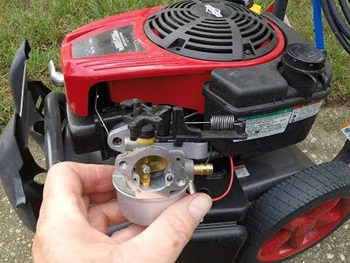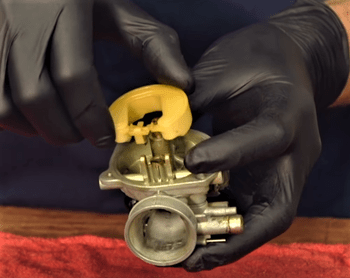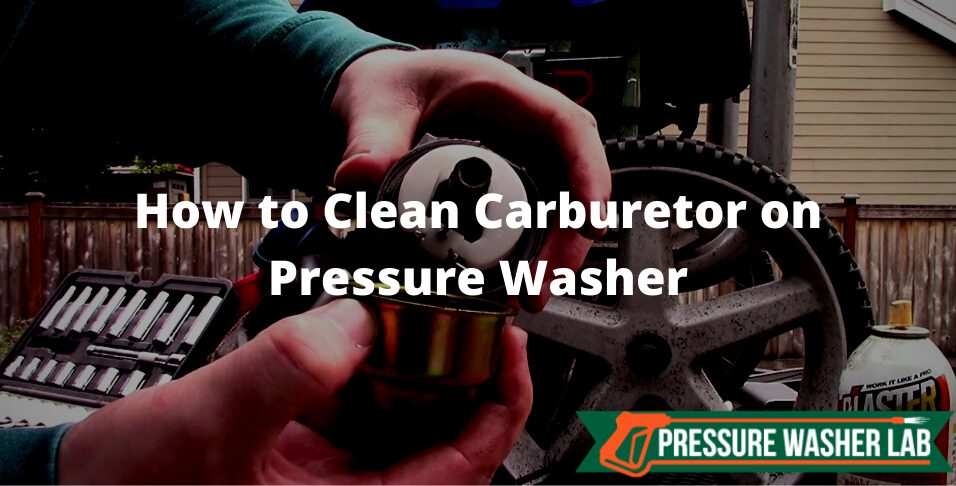Cleaning a carburetor on pressure washer requires getting the component out of the unit, taking all its pieces out, applying a carburetor cleaner, and assembling it back together. Before cleansing a pressure washer carburetor, for it to be handled safely, the fuel valve should be removed and the tank should be emptied.
A pressure washer carburetor has to be cleared of residual gas and checked for corrosion before the bowl is removed and before all the pieces of the carburetor are taken apart. Cleaning a pressure washer carburetor requires spraying all its dirty components with a carburetor cleaner, except the parts made of rubber, which have to be cleaned using soap and water. This procedure is the final step after which the carburetor can be assembled back together and put back into the pressure washer. The steps for cleaning a pressure washer carburetor are discussed in detail below.
What Do Carburetors Do?
 The carburetor ensures that a pressure washer has a proper air to fuel mix and keeps the fuel and the air pumping. The carburetor needs to maintain the air to fuel ratio needs to be maintained between 12:1 and 15:1. When a carburetor gets clogged, it doesn’t burn the fuel, consumes more fuel than necessary, or fails to mix air and fuel in accordance with the recommended ratio.
The carburetor ensures that a pressure washer has a proper air to fuel mix and keeps the fuel and the air pumping. The carburetor needs to maintain the air to fuel ratio needs to be maintained between 12:1 and 15:1. When a carburetor gets clogged, it doesn’t burn the fuel, consumes more fuel than necessary, or fails to mix air and fuel in accordance with the recommended ratio.
Signs That a Carburetor Needs Cleaning
Signs that a carburetor needs cleaning include failure on startup, popping and sneezing sounds, black smoke, leaks, malfunctioned engine, and backfiring, all of which are explained below.
- Failure on Startup
If the carburetor needs to be maintained, it takes more effort to get started or doesn’t start at all. When air and fuel are not passing through the carburetor, it is a sign that the carburetor should be cleaned.
- Popping and Sneezing Sounds
Popping and sneezing coming from a carburetor indicate that the fuel and air don’t mix well or there is an imbalance between them. When an insufficient amount of fuel is running through a carburetor, it should be cleaned.
- Black Smoke
Black smoke coming from a carburetor indicates that more fuel is running through the combustion chamber than it should.
- Leaks
When the carburetor is clogged, fuel can’t run through it and it starts leaking or overflowing the carburetor.
Malfunctioned engine
A malfunctioned engine could be a sign of a clogged carburetor since the imbalance of fuel and air in the carburetor can cause the engine to underperform.
Backfiring
If the mix of air and fuel in the carburetor is imbalanced, the unit will start overheating and cause damage to the pressure washer engine.
Steps for Cleaning Your Pressure Washer’s Carburetor

Steps for cleaning a pressure washer’s carburetor are explained below:
1. Turn the Fuel Valve Off
Remove the cap of the spark plug and turn the fuel valve off to stop the fuel from passing through the carburetor.
2. Access the Carburetor
Remove the throttle cover, the intake setup, and the air filter box access the carburetor.
3. Empty the Gas Tank
Find the gas line that is connecting the carburetor and the fuel tank, take out the tube from the nipple of the carburetor, and empty old gas. Place a towel underneath the carburetor to absorb drips.
4. Remove the Carburetor
Remove the carburetor from the pressure washer’s engine using a nut driver or a socket by disconnecting two bolts that are connecting the carburetor and the engine. Disconnect the throttle cable from the linkage of the carburetor.
5. Remove Residual Gas
Once residual gas is removed, the carburetor should be inspected for leaks and corrosion. If the carburetor is corroded, it should be replaced.
6. Take the Carburetor Apart
If the carburetor is not corroded, remove the bowl by unscrewing the bottom of the carburetor to expose the float of the pressure washer, no matter if it is a commercial pressure washer or a regular model.
7. Spray the Carburetor Cleaner
Spray the carburetor with a carburetor cleaner or soap and water to clean its dirty parts, including rubber parts, then rinse and dry each piece.
8. Reconnect
Reconnect all the disconnected parts to put the carburetor back together.
FAQ
1. Why do carburetors get clogged?
Carburetors get clogged if they are not regularly cleaned and the fuel is sitting for a long period in the pressure washer so dirt accumulates when the fuel is burning.
2. What can I use to clean a carburetor?
Use a carburetor cleaner, choke cleaner, acetone, gasoline, or another alcohol-based cleaner and soak the carburetor in it. Carburetors can be sprayed using an aerosol spray and scrubbed with a brush.
3. Can you use WD40 to clean a carburetor?
Yes, WD40 can be used for cleaning a carburetor without taking it off.
4. How do you clean a carburetor without removing it?
To clean a carburetor without removing it, spray the cleaning product on the carburetor, scrub it with a toothbrush, and wipe off dirt using rags or paper towels. Do not use solvent-based cleaners such as WD40 for cleaning a carburetor without removing it if there are valves nearby because they can dissolve seals and gaskets on the sides of the valve cover.

